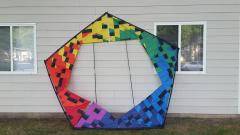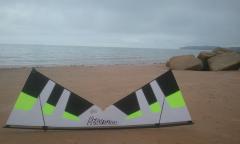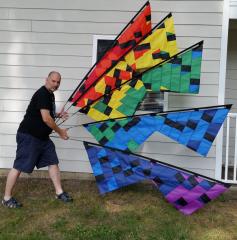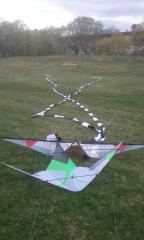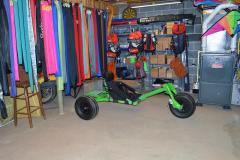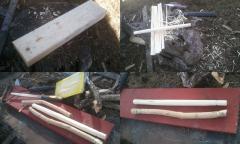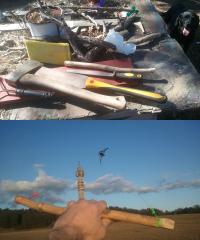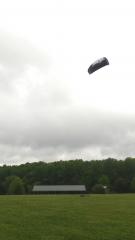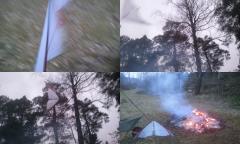-
Posts
580 -
Joined
-
Last visited
-
Days Won
27
Content Type
Profiles
Forums
Gallery
Downloads
KL Shop
Blogs
Articles
Everything posted by Exult
-
From the album: Exult's Photos
Not bringing the sleeves allow you to have plenty of kites or room in the kite(/ski) bag. Necessity is the mother of all "inventions" I've heard. Did not try it out, bringing the kites without the sleeves i.e., until recently - I had to, due to limited space when packing for travelling. Are there any disadvantages with this method compared to keeping each kite in its respective sleeve? Before leaving home, this lead to a hunt for velcro straps that comes with the kites when new to keep each kite in a roll. Before I considered them not so important, which have led to that they have diffused around ending up here and there in the kite gear boxes*. The sleeveless transport urged me to mark the spreaders by putting a white tape strip around each kite's spreader where the name of the kite has been written - just in case any spreader would escape from a kite roll. Now this is not so likely, since when disassembling the kite I always put a rubber band around all spreaders. This photo was taken during a very sunny period during a vacation trip. Without the buff I would have been forced to much limit kiting and other outdoors activities. The buff is not any special UV buff to my knowledge and was originally used when(and bought for) skiing. I very rarely wear the buff in "mugger-mode" covering the whole face in the summer, but is instead mostly interested in covering the gap between the hat and shirt. Are the UV-buffs for summer use "only" and would they be much cooler than a winter buff? I have not tried any "pure UV buff" for hot day summer use so I can't tell about any perceived differences. These sunglasses are new to me. They are large enough to allow ordinary glasses to be worn under them. They cover field of view well, leaving very small gaps along the rim. A problem with these sunglasses is that the nose pads that supports the sun glasses on the nose are just a quite sharp edges (or strips at the wrong angle) which are not comfortable after a while. These strips go around the rim of the eyeglass chassis, sealing light and adding distance allowing the corrective (normal) eyeglasses to be worn under them. Adding some kind of nose pads or at least grind the strips closest to the nose somewhat could make them more comfortable, could be DIY project perhaps. *Yes I do have an aversion to getting rid of stuff (an especially high threshold for kite stuff). There is "always" a possibility of repairing, using in repairs, using as reference when ordering or using stuff as raw material for something else (but in general way to little time to do it).-
- velcro strap
- buff
-
(and 3 more)
Tagged with:
-
-
I'll include it in the exercises and learn that thoroughly. Initially I had problems switching between holding inverted and non-inverted orientation (like entering two different modes), so I still do some focusing on the transitions between the orientations. Already holding them very light. Also thinks that some of the low wind techniques from DLK carries over into QLK. But thank you anyway! It is time for some more QLK practice. Even though I don't have any kite flying surrounding I always plan ahead, moves in planned paths/figures between tricks (DLK) and (obviously) try to make it look as good as possible (DLK and QLK). So in this aspect I guess it could be considered as a (non-existent) team flying preparation. However it feels very unfamiliar when flying two DLKs and the lines cross - so that is an aspect that remains getting used to (and flying two DLKs in itself still requires some more "getting used to"). The least (solo) teamflying-like is trick flying in my opinion, especially when randomizing input to see what the kite wants to do.
-
I bought this line set ready made 15m long (49 foot). I kind of figured that since QLK is more of precision and positioning the kite in different places 15m would not result in a too small window considering that I sometimes do fly the 4D on 18 foot lines (6m). But as I said I just started out learning so I'll will surely notice the difference and possibly I'll change my mind when I meet more wind. Good to know (assuming that "the verticals" are the two spars connecting the front and trailing edge and that they snap in high wind). My DLK reflexes knows this thoroughly, while my QLK self knows this mostly only limited to theory unfortunately. Most often I only pull the brake(/rear) lines when the kite to ground distance rapidly decreases. On the other hand normally you fly faster and more frequent in the forward direction. Hmm.. possibly I should do some fly fast-slowly-fast exercises with varying line tension (and pitch angle) to get this going?
-
When warming up for the dive stop I do horisontal flight with the leading edge first and then do the sudden stop instead of starting out with a more dramatic vertical dive. The input is the same as when doing the dive stop to my understanding. This developed into an exercise flying from side to side, turning by making the sudden stop and then the actual 180 deg turn on the spot to fly off in the other direction (but that is another story). But bear in mind when evaluating my answer, in this aspect, I am a beginner as well.
- 212 replies
-
- 1
-

-
- tips
- san francisco
- (and 4 more)
-
From the album: Exult's Photos
To describe someone who had changed their ways/opinions/activities with age (often to something milder) my father used the expression(/proverb?): "When the devil grows old he turns religious". OK, this may not be the a perfect application of the expression, but here is my first framed quad, on a beach in Sidmouth (UK, Devon). Except for one day the wind here has always been much lower than the forecast making (especially inverted) hovers difficult to practice. I unfortunately didn't bring the lighter set of spars (the 2 wrap ones) during this vacation trip out of fear that my rookieness would break them (they remain at home in their original bag). What is the most common way of breaking quad spars - breaking the spars in the air (due to high wind/hard input) or when doing "unplanned landings" with a powered kite with tensioned lines? So far I've only tried the 15m lines, mostly due to the low wind (and sometimes lack of space), but I find it an OK length of learning on (without having tried the 25m line set yet). I'm sure that previous DLK experience makes it easier to pick up QLK. The make shift thought model that the brake lines (rear lines?) corresponds to pulling the right/left DLK line gets you far. To start with QLK has also given me perspective on DLK. The DLK precision in figures, starting/landing, etc..., that I've taken for granted is more evident for me now when I can compare it to my currently more wobbly QLK piloting. -
-
I've been completely off from KL for a >month (really "enjoying" the time by doing overdue paperwork of the type I-don't-even-know-how-and-where-to-start and handling family issues - OK, not all was a boring horror - I did something unusual, for a change I bought a framed quad (in fact the first that I ever seen)) and what happens: First, there is a quad clinic in Denmark, i.e. relatively nearby (extremely rare), which tuned out to be sold out (OK I'm a duali type, but hey contacts are worth gold in my kite forsaken part of the world). Second, one of the participants turned out to be a man that I've have received so much good and early advice from. This is my old kite guru from the days (end of 90-ies) when I started out seriously, that suddenly surfaced here after about 18-19 years! I'd say that he is the one who really introduced me to kiting. From looking on his profile page (as of Fri Jun 30 12:41:53 BST 2017) I'd say he has chosen a much humble approach here. In addition to the "Aerialis team captain" he is a kite designer, (former?) national director of STACK Sweden and a former kite shop owner. His more recent achievements, i.e. during this millennium, I'm not updated on with the exception of being one of the organizers of a recurrent kite festival i Denmark, "The Nordic Kite Meeting"/"Blokhus dagefestival" ( https://kitelife.com/kl-archive/nordic-kite-meeting-2013/ ). Thank you @Anders Matson for time after time sharing advice patiently (phone-wise) at a time when it really mattered!!!
-
Hello Kevmort or anyone else close enough, This is a long shot, but if you now happen to be any where near Sidmouth (Devon, UK), possibly on vacation, I'm here for a week more (ending early July 2017). I brought a decent sub set of my kites (mostly duals, but also my new first framed quad (and yes I'm really a rookie here)). I don't have a car, but could imagine going by bus for an hour or so if someone happens to know "the perfect field". I'll be in Sidmouth and be able to do kiting until Thursday 6th of July (or possibly parts of Friday the 7th as well). How is Sidmouth as a kiting area? - well OK if the wind got any south component in it, ie coming in from the sea. Surprisingly quite low winds, so so far I've mostly been using the HQ Shadow mostly. Otherwise it is cow dependant, i.e. which pasture they happen to be in, which can lead to long walks if you are determined to do kiting. If the tide is in the remaining part of the beaches consists of sorted round pebbles typically in the range 2-7cm. Most places they slope rather much.
-
From the album: Exult's Photos
A few times the kites collided with a muffled sound. Well nothing broke but one time the kites started to spin and left the four lines in a twisted mess. I guess that I could offset the kites by making one line set a metre shorter than the other. In this way the "hit effective cross section" should be reduced and only be limited to kite/line collisions and exclude the kite/kite collisions. Would one notice in any negative way, a metre of difference in lengths between the line sets for a line length of 30m (98ft)? It just struck me that the "reflexes" to give line to make any kite to ground contact milder should ideally apply to kite collisions as well. -
From the album: Exult's Photos
Afternoon, 6th of May 2017 Ladugårdsgärdet, forecasted 4-5m/s 2 x Kymera on 30m 50kg lines Ready to roll up into launch position by using a hard wind parking method (the lines/leaders up and around the trailing edge so that the kite can be rolled forward into launch position by pulling the lines). It wasn't always necessary with this type of start, conditions were quite OK today, but was sometimes a bit on the lower side - no tail weights fitted (serves no purpose here anyhow). If you want to apply low wind techniques you need to have both the noses pointing either up or down at the same time. The wind range that I can do do dual DLKs is quite narrow given my current skills. Low wind means that the kites needs to be synchronized as just stated when flying up/down and hard wind well that is just makes the kites move too quickly. Perhaps going to 40m would allow higher wind speeds, since there would be more room to maneuver the kites? Most of the time I let the kites go left right in rather synchronized way. Often had them high up in the window, so my neck got a bit sore after a few hours. When doing normal (single) DLK tricking, I'm closer to ground most of the time which doesn't strain your neck. Even though I kept it simple, mainly striving to keep the kites in the air and avoiding the un-planned landings (which worked for some minutes at a time at best) I was quite satisfied. -
I think that the Infinity (246cm/97" span width) can be a good second kite once you are well beyond the stage of un-planned landings. It is a robust kite that only broke once for me when I really asked for it. It is good natured when it comes to turtles and lazy susans. When entering a fade from a fractured axel it it the kite that gives me the highest success rate. It is not for the lowest wind range and got some mass/response that you can feel when tossing it around (which I like). I have not found anything I didn't like except for the turning radius at the edge of the wind window, but this get less pronounced when adjusting the bridle for somewhat higher wind). I remember that you recently discussed line lengths (http://kitelife.com/forum/topic/7880-welcome-philm63/ and http://kitelife.com/forum/topic/7889-line-lengths-for-beginners/). When being out with the Infinity I normally use 20m (66 ft) and 25m (~82 ft) lines.
-

green buggy arrives in the Kite Dungeon
Exult commented on SHBKF's gallery image in Member's Galleries
I like to hear about your new stuff, including any educational comment of some special feature of an item. B.t.w., for a swede the headline "green buggy arrives in the Kite Dungeon" when translated, starts to sound like a tale. We use the word "drake" both for kites and dragons. So a green (default colour of a dragon?) dragon buggy in the dragon cave... -
There is a difference between @philm63 and @philm63. The latter one causes a notification appear for the one who is addressed. To generate the latter, input an "@", then type the first few characters of the recipient slowly to make the list of possible names appear and then pick the right name. Get some sleeving (perhaps you already did?) and you can have a 65 and a 35 foot line set. Sorry for nitpicking, but the lines that go with the Spider are polyester... (sorry again). I'd say that larger kites are easier to trick/fly, but that I suspect that they crash more destructively. Larger kites are more easy to keep stable in a stall than small kites - noisy input is kind of low pass filtered or at least the input gets more averaged. If your hands know what to do (i.e. give slack) automatically one span width above the ground when the ground approaches rapidly, then the risk of crashing destructively is small. Having this ability, you are in the position of deciding the level of risk that you want to subject any new and more expensive kite to. However don't postpone the purchase of the second kite too long so that your learning slows down. After all, kites can be repaired. My experience with smaller beginner kites is not so large - I did not start out with such a kite (not counting some sessions in the mid 80-ies). I instead started out with a DLK that had 213cm/7' span width and a rather low aspect ratio (Jam Session (-98?)) and has stayed most of the time in the 2m to 2.5m range. I lost count of the times I repaired the Jam Session, but I favor quite much ground contact and especially at the time (experimented with) quite hard input. A bonus was that when buying spares from the right kite dealer I always got a lot of hints. Occasionally during last two years I've started flying both larger and smaller DLKs than this range.
-
Enjoy this time of exploration. Thinking back on my own time as a beginner I almost envy this stage of having started in getting going and starting to discover, though I don't believe that there is ever an end to learning. After the initial left/right control makes sense, start on landings, stalls and just barely flying - perhaps by making small jumps (decimeters)/landings on a low wind day. Stalling and landing is certainly a part of it. A cart wheel recovery (which increases the effective training time by saving you a lot of walks) doesn't even need to be taught at a very good/large kite field (though you happened to have one just around the corner!). A bit surprising that you during this early phase of learning wish for a shorter line and not one that gives a larger distance to the ground. Is the field very small or you feel like you would get better control with the shorter line? In my ears it sounds like you must have made some progress when even considering a shorter line set. Regarding the choice of kite - go through a couple of crash/repair cycles until they become rare before you upgrade I think (not that I've ever tried an ITW Spider). Though replacing a RTF (ready to fly) polyester line can increase the response/control of the kite.
-
If QLK is the "the sh*t" I should probably stay out of it - not even look in the direction of it. So far I've been much successful in doing so - mainly because I've not ever seen a rev like quad IRL. I have gotten very much addicted to dual line kites. There is no end to the possibilities to learn when it comes to DLK (and I'm sure the same applies for the QLK as well). @Aero, I'd be happy to hear from you no matter the way you decide to go (or both).
-
From the album: Exult's Photos
Upon arriving to the beach/field the day I was going to try the new handles doing quad line and dual DLK it looked like I just had missed out some high wind action... . So how was this first attempt with two DLKs. The Hydra was on 20m lines and the Kymera on 25m lines (as often before). At this early stage of my "dual dual" training I could not notice any drawback with this unsymmetrical arrangement. Crash avoiding and some rudimentary left/right control are the main issues. The attempts that lasted often were (or bore resemblance to) two lying figure eights. When doing the figure eights both the kites were going left/right at the same time without the lines crossing. Well one more recommendation - don't try to be to clever when (or be careful at least) when attaching the line to a handle. I was lazy and let the handle remain and hang lose, which caused a difficult line tangle. Recommendations from a beginner, based on this event: Get going - you don't need the perfect gear from start and you may already have the required items and can make some simple handles yourself if needed (perhaps a quad handle if available would do?). You don't need two identical kites for the initial training. Possibly you could try with some longer lines if available and if the field is large enough - after all if you are new to this you are likely going to feel like first time dual beginner. Actually this is a good remainder of how it was being a beginner when you see an absolute beginner "landing" your kites again and again. -
From the album: Exult's Photos
For the second handle I had run out of long enough pieces of lilac* - they had already been cut to lengths suitable for the fireplaces. I stuck to the zero budget way and went for some short just long enough surplus wooden planks of spruce with nice uniform fibre direction. I heard somewhere a long time ago (as a child in fact), that to make the bow strong of certain ships, the wooden planks were cracked into shape along the fibres (sounds difficult for long planks though). Well since I have no lathe and the spruce wood is low density, but yet the handle should be strong/stiff enough - why not give the method a try? If would find that there would be an advantage with curved handles I should consider all curved pieces of wood from the garden as potential handle material and not just something to be used for heating. Usually when a branch is curved I put the cut in the middle of the curve, so that I get two semi straight logs from it to fit into the pile of logs. *Of course I could go and cut some new branches from the bushes (there is plenty of it), but I'm in a several year process of rejuvenate the bushes and do not want to deviate from this. Not until the flowering period has passed you should do the cutting. The first year you do the central parts of the bushes, later years you work your way more outwards and during the third and fourth year you work at the "surface" of the bush. -
That was very "field-creative". I prefer to do things in advance if I'm given the choice to do so. The in field crafty things for me is mostly limited to simple temporary tape repair (non-tedlar and non-ripstop). Well, an exception, a not so fashionable temporary paperboard brim was fitted to a brim-less hat about a month ago - the during the session available way to deal with a low and much annoying sun.
-
Thank you for this piece of info. Now I can save valuable time by skipping the intermediate stages of dual DLKs and tripple DLKs and instead go for quadruple DLKs!! More down to earth, I have no idea how much I'll pursue this latest fad or even if I'll ever stop lawn darting one of two kites after a short while (the remaining one usually is no problem). Will two kites give you the piece of mind during a long session? Do I want to take time from more standard DLK activities? And, you are back again to the situation with no free hands and therefore no in air photos of the kites.
-
-
From the album: Exult's Photos
Before leaving for a kiting session I invested 20 minutes time to create a bar handle. The zero budget material (pointless going for some fancier before knowing what you want) I chose to use was a pin of lilac - a very hard material. In fact it is the only type of hard enough pins that last when playing with the German Shepard. In the background you can see a very frequent visitor - a Field Labrador (a more original Labrador type, quick/quick turning, jumps over high fences and with a very strong and constant desire to fetch). It may look innocent, but is the worst constantly-in-to-play "garden assistant" I know. I don't want to know what would happen to a flying kite in its vicinity. Learning to fly by using a handle was surprisingly quick (compared to trick learning). OK a few nose dives, but that was really expected. The handle was a bit too short because I couldn't do any snap stalls and no cart wheels (assuming this a a reason). Hopefully both hands will be strong enough to manage longer handles when doing quick movements. Off the kiting field I've started to use the left hand more and sometimes just wiggle my laptop quickly (or tilting my bag) while waiting in a line e.g. to get some more left hand exercise. A boost in kiting confidence was when the one hand fade launch worked. While cart wheels didn't work, fade launches became the remaining choice when the kite was not in a normal start position. -
So how does polyester or nylon ripstop age? I'm thinking of my Flying Edge (kite model or brand?, mid 80-ies), Jam Session (end of 90-ies), (end of 90-ies) Maestrale, (end of 90-ies) Paw (end of 90-ies) and City session (end of 90-ies) when considering the case of no UV radiation - kite just being exposed to air? Already noticed that the rubber string nock sail tension string of the Flying Edge is no longer flexible, but more or less breaks when being touched. Should they be handled with silk gloves?
-
-
From the album: Exult's Photos
Fri Apr 14 14:06:33 CEST 2017 Neighbor's lawn, possibly 1m/s 4D on 6m 25kg lines Drinking, kiting and colliding with a non-kiter(*) - how does that taste? My summer neighbor was likely a bit bored when guarding the garden fire, so he asked me over for a garden beer. I decided to bring my 4D, but I didn't have very much hope of being able to use it because of lack of open space and (presumed) undisturbed/non-turbulent wind. The wind direction was wrong for the normal nearby field for the whole extended Easter weekend, so I felt a bit desperate. The usual question/statement came: "But there is no wind". So I explained that it was the quality of the wind and lack space that was the concern and assembled the kite. Well it was crowded and limited to fly between the trees and around the supposedly roe-deer-attacked-once-a-tree-plant on the mini kite field (metres wide). Yes, the wind direction was so that the smoke from the fire went there as well. I'm not going to bore you with details of this much limited flying, but instead point out what could be the most valuable thing learnt (or at least something I'm going to investigate further) - the quality of the wind was kind of OK, despite the fact the there were a few low trees (still without leaves) close and upstream. For low wind speeds is the requirement of the field size much less strict? And the kite-attack I promised above - how did that happen? Well you see the answer though you may not realize it. This time I had the luxury of someone holding the camera so that I could get a few pictures of the kite in flight. As a "thank you" for the close up photo I (accidentally) hit him with the kite. I can't have been such a bad pilot at this occasion anyhow, since the 4D didn't end up in a tree - but that was a poor comfort for him. My cardigan strongly smelled of smoke for days afterwards. * Any higher wind speed or heavier/larger kite can really cause damage - don't do it!


